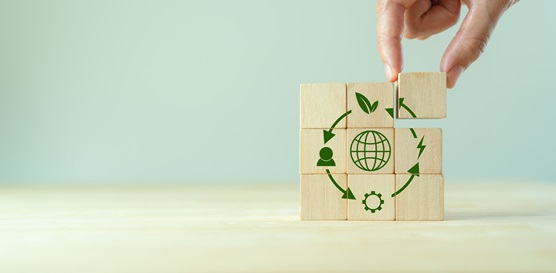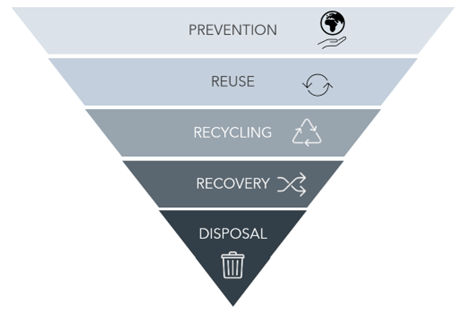
© Adobe Stock
The circular economy has been discussed for about ten years, and the term has become a part of everyday language rather than just professional jargon in recent years. The circular economy emphasises promoting material cycles through reuse, repair, product longevity, and upcycling. Even before the term circular economy became widespread, the waste hierarchy has served as a guideline for minimising the environmental impacts of material use and waste management.
According to the waste hierarchy, the primary focus should be on preventing waste generation and promoting reuse, and if that is not possible, efforts should be made to recycle or recover energy from materials.

The waste hierarchy has served for decades as a framework to minimise the environmental impacts of material use and waste management.
The Nordic countries have been global pioneers in developing roadmaps and strategic programmes for the circular economy. However, in practice, the circular transition has proven to be challenging.
For example, in Finland, the circularity rate for materials has lingered around three percent for years1. Additionally, raising the recycling rate of municipal waste has proven to be a challenging task, with little significant progress seen in the Nordic countries for past years2. The public debate continues to be dominated by a focus on recycling, rather than prioritising waste prevention and the promotion of reuse.
In the project “Waste prevention in the Nordics: What policies and measures are needed to prevent waste production and promote reuse?” commissioned by the Nordic Council of Ministers, this gap was addressed.
The project's aim was to identify best practices for waste prevention and the promotion of reuse in the Nordic countries.
Below are three key observations on the topic.
1. Waste prevention covers not only the reduction of waste volume but also the minimisation of adverse impacts of waste.
Waste prevention should aim to reduce the consumption of virgin raw materials, as well as to minimise the negative impacts on the environment and human health, including the content of harmful substances in materials and products. The perspectives of reducing harmful substances and environmental impacts are often overlooked when the discussion is solely focused on the volume of waste.
For instance, in the recycling process of plastics, concerns have been raised about the potential accumulation of harmful substances3,4, while plastic recycling facilities can also be sources of microplastics5.
2. The Nordics have "low-hanging fruits" that can be leveraged to scale up waste prevention; however, existing measures are primarily based on voluntary efforts.
The project identified dozens of measures at various levels that promote waste prevention. Examples of highly effective and easily implementable actions include promoting the circular economy in public procurement, as well as green deals and material efficiency commitments.
Promoting the circular economy in public procurement. Integrating circular economy criteria into public procurement can significantly reduce waste generation and enhance sustainability in cities.
Example: The city of Espoo has developed circular economy-oriented procurement criteria for construction plastics in the "Closed Plastic Circle" project6. In the future, these procurement criteria could be used to more strongly guide not only recycling but also waste prevention and reuse.
Green deals and material efficiency commitments. Green deals and material efficiency commitments made by industry and sector organisations aim for improved resource efficiency, sustainability, and the reduction of environmental impacts within value chains.
Example: The material efficiency commitment of Finland's food and packaging industries includes a target of reducing food waste by 50 percent by 2030, as well as reducing the use of plastics in packaging and promoting the reuse of packaging.
While various voluntary measures are important for promoting the circular economy, it is inevitable that significant reductions in the consumption of virgin materials and the amount of waste will also require a new approach to policymaking – including stronger regulatory and economic guidance.
3. Waste prevention requires a completely new array of policy measures beyond traditional waste policies.
Policies that promote waste prevention are not based on the incremental improvement of recycling-based policy measures. Instead, the transition to the circular economy means a complex sociotechnical change, where a comprehensive policy mix focuses particularly on the production and usage phases of products, thereby helping to restrain the overconsumption of virgin natural resources.
Olli Sahimaa works at Sweco as Leading Consultant in strategic circular economy projects.
Susanna Sepponen leads Sweco’s activities that support national and Nordic policy and program development.
Julia Virtanen works at Sweco as Consultant in projects related to circular economy and sustainable use of natural resources.
Results of the “Waste Prevention in the Nordics” project, funded by the Nordic Council of Ministers, were presented at the PlastLIFE project's annual seminar in November 2024 in Helsinki.
Reports
Waste prevention in the Nordics (norden.org)
Policy Brief: Effective waste prevention needs policies targeting the entire value chain (norden.org)
References
1. Statistics Finland. (2022). Circular economy is progressing slowly in Finland – the most significant steps towards the set goals have yet to be taken (in Finnish, stat.fi)
2. European Environment Agency. (2024). Waste recycling in Europe (europa.eu)
3. Hahladakis, J. N., Velis, C. A., Weber, R., Iacovidou, E., Purnell, P. (2018). An overview of chemical additives present in plastics: Migration, release, fate and environmental impact during their use, disposal and recycling. Journal of Hazardous Materials, 344, 179-199.
4. University of Gothenburg.. (2023). Hundreds of toxic chemicals in recycled plastics (gu.se)
5. Brown, E., MacDonald, A., Allen, S., Allen, D. (2023). The potential for a plastic recycling facility to release microplastic pollution and possible filtration remediation effectiveness. Journal of Hazardous Materials Advances, 10, 100309.
6. City of Espoo. (2024). Newly released public procurement criteria improve recycling rate of construction plastics (espoo.fi)